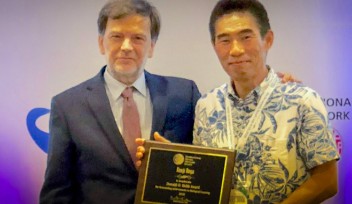Woman Technicians at OIST
In approximately 50 research units at OIST, 110 technicians contribute to advance the research. Their tasks vary from analyzing great quantities of research data, to rearing living creatures, and performing experiments. OIST’s research technicians possess unique and diverse talents. They originate from many countries, but all have experience and expertise suiting the tasks they perform. When asked what motivates them, all responded with intriguing stories that led to their coming to OIST.
Seiko Yoshikawa, a technician in the Formation and Regulation of Neuronal Connectivity Unit, wanted to understand living things and majored in biological sciences. After 9 years in RIKEN, Ms. Yoshikawa moved to OIST. “As a technician at OIST, I can engage in various types of life science research without being restricted by boundaries between disciplines. This is one of the benefits of this position.” Her unit uses fruit flies to analyze genetic control of neuronal networks, and she is responsible for DNA analysis. She has also had the opportunity to explain her research to high school students during an OIST campus tour. Her Unit's research leader Takakazu Yokokura told her, “If you are going to do it, get something out of it.” This philosophy always encourages Ms. Yoshikawa to undertake new challenges.
Kanako Hisata, a technician in the Marine Genomics Unit led by Prof. Noriyuki Satoh, related, “I still remember the moment 20 years ago, when with a newly published academic book by Prof. Satoh in my hand, I asked him for his autograph.“ Ms. Hisata, has now become an invaluable resource for the professor. In February, Prof. Satoh published another academic book, which contained many clear, colorful figures. This book compiled all of the ascidian studies to which Prof. Satoh dedicated most of his career. It was Ms. Hisata who created most of those figures. He says, “Without her, this book could not have been completed.” Their collaboration is likely to continue as long as the research itself.
“I am delighted that I can participate in cutting-edge research, in spite of my non-scientific background,” says Masako Ogasawara, with a sparkle in her eyes. After 7 months of working in the Biodiversity and Biocomplexity Unit as an assistant, Ms. Ogasawara was promoted to Technician. Using ants, of which there are an estimated 25,000 species, the Unit seeks to understand the origin and maintenance of biodiversity, from both ecological and evolutionary perspectives. Ms. Ogasawara supports the research by mounting specimens and photographing them using a microscope. “ Many researchers might find this work laborious and time-consuming, but I find it fascinating,” Ms. Ogasawara said.
Technician Kun Xiao from China works in the Developmental Signalling Unit. She loves living creatures and her task is to propagate the Unit’s fruit flies, several dozen of which are reared in each of approximately 2,400 tubes. The first task she was assigned was to give them fresh food every 2 weeks. It requires considerable time and effort, but Ms. Xiao explained that it is rewarding to be responsible for maintaining the colony. In the near future, she will also begin to participate in protein analysis experiments. “I am very much looking forward to this new task, which will expand the range of work I can do. Every day at OIST is a learning experience—even just to speak English,” said Ms. Xiao cheerfully.
With diverse, interdisciplinary research projects here, OIST needs individuals with great depth of experience in a multitude of skills. All of these women technicians make important contributions to the research at OIST and their enthusiasm brightens up the research units --- they are an essential element of the university.
By Mayumi Nishioka
For press enquiries:
Press Inquiry Form


















